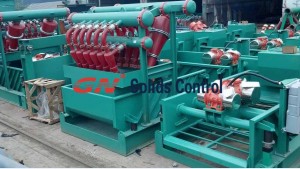The drilling fluids with the cuttings from the well are discharged to a rig shale shaker where the cuttings are separated from the drilling fluid. The separation step does not completely remove drilling fluid from the cuttings, some drilling fluid and additives remain on the drill cuttings.
Then such drilling cuttings with drilling fluids will be dropped into a GN drilling waste system, through physical way to separate the usable drilling fluids with unusable drilling cuttings. For example, hi-G shale shaker to separate larger drilling cuttings, then verti-cutting dryer to separate drilling cuttings with oil less than 5%.The usable drilling fluids are treated by decanter centrifuge, then clean drilling fluids and water will back to rig again.
The cuttings separated by verti-cutting dryer with less than 5% oil can not be drain off directly, it may pollute the environment. We must use chemical way to continue the treatment.
Drilling cuttings treatment method:
Thermal desorption, re-injection, incineration and solidification.These methods have been applied in the site, they may have their own advantages and disadvantages.
Thermal desorption:
use of the patented Porcupine Processor to remove all water and oil, leaving a residual total petroleum hydrocarbon on cuttings of less than 1%.
Re-injection :
Drill cuttings are slurrified with water (fresh or sea water) and ground down to a pre-determined particle size. The particle size is achieved by passing through a shaker screen. Slurry of the correct particle size and physical properties is injected via a pump, which is typically of a triplex design, into the well head at a given pressure and down into the predetermined sub-surface injection zone. Oversize particles from the shaker are re-circulated for further grinding.
GN drilling cutting treatment equipments are utilized in Brazil for various site. For any project in Brazil for drilling cuttings treatment, pls contact GN service dept. in Brazil.
